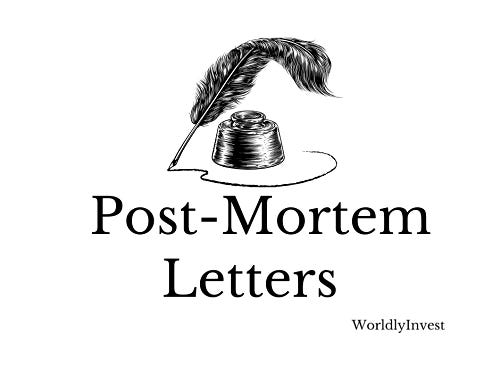Mistaken Investments from Investor Letters (Part I)
A post-mortem analysis by Rob Vinall of RV Capital on Ryman Healthcare.
Post-Mortem Analysis: Ryman Healthcare – RV Capital
Every investor has battle scars. In his H1 2025 letter, Robert Vinall of RV Capital took the unusual step of writing at length about what he calls “by far the worst investment I have ever made.” The company: Ryman Healthcare a New Zealand operator of retirement villages.
Rob first invested in 2017 at NZ$8.60 a share. By the time he sold the last of the position in early 2024, shares had fallen to NZ$4.50. It was the fund’s first meaningful long-term loss.
Why Ryman Looked Attractive
The Ryman story began in the 1980s with founders Kevin Hickman and John Ryder, who were inspired to create retirement care facilities “good enough for Mum.” Their model reinvested profits to fund new villages, pioneering the “continuum of care” concept where residents could age in place through multiple stages of retirement.
The company’s mission focus, paired with an innovative financing model called the “occupancy advance” (residents pay an upfront sum for lifetime occupancy), made it seem like a win-win for all stakeholders: retirees, shareholders, and society. With New Zealand and Australia’s aging demographics, the growth runway looked enormous.
Where It Went Wrong
Over time, Ryman lost the balance between mission and commercial discipline. Vinall points to a series of compounding problems:
Leadership transition: ounder Kevin Hickman stepped down as chairman in 2018 and long-time CEO Simon Challies retired a year earlier, both due to illness. Their departures marked the fading of a culture of frugality.
I did not pay sufficient attention to organisational changes shortly after we invested.
Debt spiral: Ryman expanded aggressively into more capital-intensive projects—large condominium-style villages rather than smaller, quicker builds. COVID delays, cost inflation, and housing market slowdowns added to the strain. Debt ballooned, and the company was forced into two dilutive capital raises (2023 and 2025).
A further mistake was not acting when the Company’s debt grew. I hate debt and would normally never invest in a company with high debt levels.
Flawed reporting: Ryman’s preferred metric, “underlying profit,” included non-cash gains from house price inflation, creating a misleading picture. Negative cash flow was obscured, and even management appeared to have convinced themselves the business was healthier than it really was.
I was also not sufficiently critical of Ryman’s financial disclosure. Its central earnings figure, underlying profit, was not fit-for-purpose. It gave the company credit for non-cash earnings from house price inflation and masked its negative cash flow. I was conscious that the underlying earnings calculation was flawed, but I could form a reasonably complete picture of the financials through my research. Ultimately, the biggest problem was not that the company fooled me about the health of its business, but that it fooled itself.
Dividend policy: Despite burning cash and needing capital, the company kept paying dividends to satisfy certain shareholders. Vinall pressed for suspension, but management persisted—an emblem of a board thinking like managers, not owners.
The final issue I saw, but did not weigh appropriately, was the company’s dividend policy. Up until the first capital raise, Ryman continued to pay a dividend. This made no sense at a company whose capital requirements far exceeded the cash it was generating. I pressed the company to retain all earnings until it was free cash flow positive, but ultimately, they deferred to small but influential shareholders who valued regular dividends. It was a small but telling example of how the management and board were not thinking like owners but like professional managers trying to keep the peace.
Lessons
Looking back, Vinall admits he misjudged the trade-offs. He saw Ryman’s positive attributes clearly — its brand, its model, and its demographic tailwind — but underweighted the negatives: rising leverage, eroding culture, poor disclosure, and capital misallocation.
He writes:
The problem was not that I misjudged its positive attributes. It was that I did not properly weigh them against the negative ones. No investment is ever perfect, and the skill is weighing the upsides against the downsides. In this case, I got the trade-off wrong.
For him, the most galling oversight was cultural: he failed to fully appreciate how much of Ryman’s DNA was tied to its founders and long-time leaders. When they left, frugality and discipline went with them.
Seen through the lens of crisis and missed red flags, Ryman looks like an incredibly dumb investment idea. That is not entirely fair to me and, more importantly, Ryman. Ryman is a great company with many of the attributes of a great investment. It is a national treasure in New Zealand as it has positively impacted the lives of virtually every Kiwi. The “occupancy advance”, whereby incoming residents purchase a right to stay in their unit for the remainder of their lives, is a brilliant business model innovation. It perfectly aligns the interests of all stakeholders: the retiree (who is capital-rich, but income poor), Ryman (who needs capital to build villages), the shareholder (who can compound earnings in a capital-light way) and society (who wants to see its old folk taken care of and housing freed up for young families). It creates a win-win for all stakeholders when it works. And New Zealand’s and Australia’s ageing populations represent an enormous opportunity for Ryman for decades to come.
You need to create an account to read the letters




Great deconstruction.. feels like he believed in it so deeply he talked himself past the red flags...is that your take too? Humbling reminder for me
I see..Iwould be in a hurry to pare down if I were in his shoes 😄